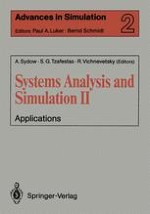
1988 | OriginalPaper | Buchkapitel
Application of a Hierarchical Computer System for Picosecond Technology
verfasst von : S. Geschke, N. Kempe, H. Schlawatzky
Erschienen in: Systems Analysis and Simulation II
Verlag: Springer US
Enthalten in: Professional Book Archive
Aktivieren Sie unsere intelligente Suche, um passende Fachinhalte oder Patente zu finden.
Wählen Sie Textabschnitte aus um mit Künstlicher Intelligenz passenden Patente zu finden. powered by
Markieren Sie Textabschnitte, um KI-gestützt weitere passende Inhalte zu finden. powered by
The unique properties of pico- and especially femtosecond laser light pulses allow for the first time a deep insight into the nature, into the temporal evolution of some of the most fundamental processes in matter, such as the free decay of molecular vibrations, electronic relaxation processes in small and large molecules as well as in solids, phonon decay and energy migration in solids, charge transfer processes and other non-radiative transfer processes, elementary processes of photosynthesis and-of other biological phenomena. Moreover, picosecond technology has provided new possibilities for the manipulation of photophysical and photochemical processes and it is necessary for a number of modern technologies such as the heterogeneous catalysis, making extremly fast electrooptical components, e. g. switches, modulators and receivers, for different kinds of modern electronics, optical computing technique and for biological technology and edicine. This situation makes high demands on the scientific instruments in this field, especially because the majority of the users of these instruments are no “lase-scientists”. On the other hand, a great number of such instruments is the basis for the investigation of phenomena, not yet fully investigated. This report is to show how we in the Centre of Scientific Instruments approached the problem of optimized equipment for various applications with very high flexibility and convenience by means of modern microprocessor electronics.